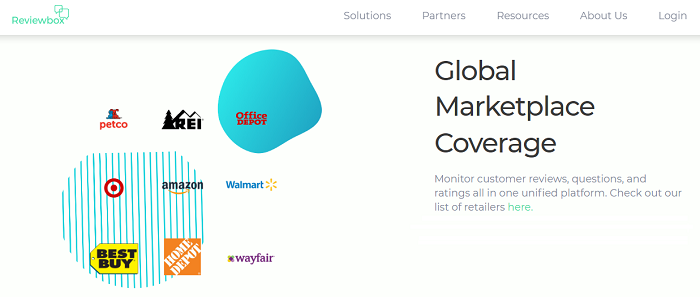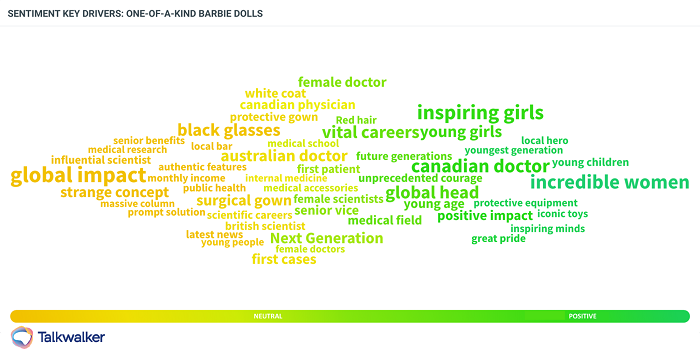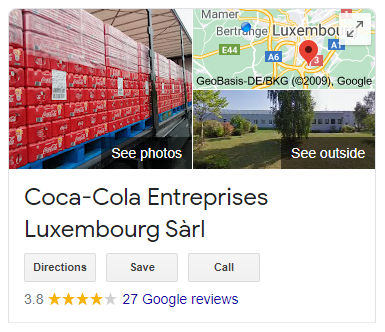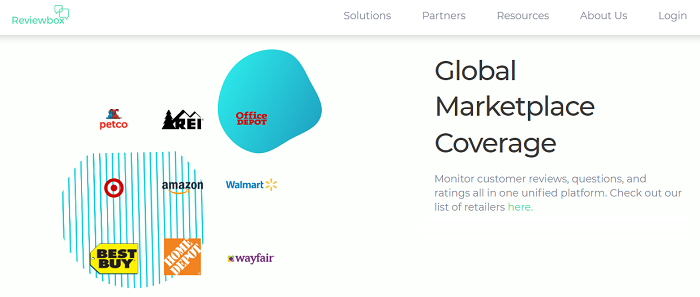Give Me Consumer Intelligence From Review Data!
Delta, Avery, Whirlpool, and Netgear are a few of the brands that use Reviewbox to monitor, analyze, and respond to customer product reviews in a single platform.
This integration will allow us to increase our e-commerce data - product reviews, product catalogs, pricing. Along with product data collected from sites that include Amazon, eBay, and Walmart, so you can manage reviews, pricing, content, and search ranking across 70+ marketplaces.

Be retail ready and successfully market, sell, and deliver products to your customers.
Reviewbox will increase the review data that we already offer our customers, that currently includes…
- Verified Reviews - including product and merchant reviews
- Trustpilot - 1 million new company reviews posted per month
- ReviewTrackers - real-time customer feedback from social media, online media, etc., to enable intelligent business decisions
- Quora - long-form user-generated content helping brands find micro-influencers, niche audiences, and content ideation
- Facebook reviews - social proof from customers so brands can improve the experience, attract more customers, and outsmart their competitors
- iOS App store reviews - customer ratings and reviews for an app, to help consumers decide
- Google reviews - business reviews that’ll increase brand discovery and trust
- Tripadvisor - Millions of traveler reviews and opinions from the world’s largest travel platform
No question, product reviews help consumers with their purchasing decisions. I’m going to take a closer look at how review data will benefit your business...
Table of contents
- What is customer review data?
- Where is review data collected?
- What is review data used for?
- How do product reviews influence purchasing decisions?
- Sentiment analysis using product review data
- Benefits of review data
What is customer review data?
Clue’s in the name. Customer review data refers to the ratings and reviews that customers share about products, services, and businesses. Customer review data looks at how consumers use and engage with a brand’s products and services. What they think of a brand.
Essential customer feedback if a company is looking to improve or develop new offerings, and streamline the customer experience.
Where is review data collected?
Remember when you wrote that review on Amazon, or shared your thoughts about a brand on Twitter? Most of us have posted our opinion about a product or brand, whether it was positive or negative, with companies collecting this data from social media, review and price comparison sites.
In addition, companies do market research and ask for feedback from customers, or send out surveys.
What is review data used for?
Brands use review data to analyze the market, for competitor analysis and product development, and to streamline the customer experience.
- Join the discussion on review sites and try to help consumers. You’ll be proving to existing and new customers the efficiency of your customer service.
- Including product reviews on your company website can increase your conversion rate, as consumers trust reviews shared by their peers.
- Adding user-generated content to a product page can increase conversion by up to 6.4%.
Take a look at How to get the most out of user-generated content for more information on how your brand will benefit from customer feedback.
How do product reviews influence buying decisions?
Which movie shall we go to? What book should I read next? I need a new phone, but which one? Recommendations for a good hotel in Munich, please?
No longer trusting hard-sell brand-speak, user-generated content influences consumer buying decisions. Media and entertainment, health and beauty, retail… regardless of industry, when a consumer needs to choose, they’ll more often than not check out customer product reviews.
Let's take a look at how customer reviews are the social proof needed by consumers finalizing their purchasing decisions…
Negative reviews can scare consumers, but...
Consumers are reluctant to buy products from a brand if it has negative reviews. While negative reviews are unwelcome, they provide consumer, product, and industry insights...
- Negative feedback about your product will help you improve your products and services
- Customers using your product in unexpected ways means you can create new marketing campaigns
- If your product is used in conjunction with another brand, it suggests a potential partnership
- Hashtags found in consumer reviews on social media can inspire new keywords and communities
- Understand the language your customers are using in reviews to align your content language and tone
But, please don’t fall into the trap of hiding negative reviews. There isn’t a business in the world that hasn’t received a negative review. Consumers aren’t stupid. You’ll damage your credibility if you try to pull the wool over their eyes.
Your best bet is to come clean with bad reviews, and use them to highlight your customer support team’s ability to solve issues and keep customers happy, while demonstrating to prospects that you’re a brand that cares.
Consumers trust online reviews
88% of consumers value online reviews alongside a friend’s recommendation. Brands recognizing the value of user-generated content - reviews and peer recommendations - share it on their websites and social media channels. Why? Because it’s free advertising. Because it’s trusted. Because it boosts brand credibility.
Word of warning… don’t be tempted to create fake reviews, or pay for them. And, ensure they sound genuine. Today’s consumers cannot be fooled with dodgy marketing techniques, and you could severely damage your brand’s reputation.
Visitors will spend longer on your site
Website visitors will spend 90% more time if it features UGC reviews. Showing reviews on your website can drive an 18% increase in sales, as visitors feel their purchasing decision has been validated. On e-commerce sites, UGC reviews can increase the conversion rate by 15%, as your brand’s credibility and trustworthiness is proven.
And it’s not just your website that can benefit from user-generated reviews, with email click-through rate increasing by 73%.
Sentiment analysis using product review data
The data that you’ve collected from social media channels and review sites is unstructured. This means it’s hard to analyze. You need a sentiment analysis tool using machine learning and natural language processing to extract meaning from unstructured text. A tool that is trained to learn and understand the difference between sarcasm, irony, and context.
A platform such as Talkwalker…
Barbie is proud to honor 6 frontline workers from around the world with #OneOfAKind dolls in their likeness. From an ER nurse to a biomedical researcher and more, these heroes continue to serve their communities, and inspire generations to follow their lead. #ThankYouHeroes pic.twitter.com/x6pdOlJNDZ
— Barbie (@Barbie) August 4, 2021
Celebrating Mattel’s #ThankYouHeroes campaign from 2020, Barbie recognized six female role models fighting COVID-19.

Sentiment analysis shows consumer conversations were over 30% positive.
Source: Market Pulse.
Our sentiment analysis feature will tag product reviews as positive, negative, or neutral, by listening and understanding the voice of the customer. The insights you collect will help you to…
- Identify what consumers like and don’t like about your products and services
- Compare your product reviews with those of your competitors
- Gather in real-time, product insights to improve product development
Our simulated consumer intelligence dashboard took data from multiple data sources, including surveys, customer support, social media, and customer reviews. This enabled us to analyze the sentiment shown towards Coca-Cola, with regard to packaging, ingredients, and flavor.

Consumer sentiment data from social media, surveys, and customer support.
Customer review data on social media revealed a clearer picture, as people expressed genuine concerns. While on surveys, respondents tended towards neutral answers.
Customer support - the dominant channel for customer issues - showed high negative sentiment, dropping once an issue was resolved.

Packaging and ingredients were the attributes that received most negative feedback, with consumers eager to switch to healthier options.
Benefits of review data
Now you know how customers feel about your business and products, here’s how you can use review data across your company…
Increase customer engagement and trust
Creating and maintaining trust with customers is vital for your brand, so you can build long-term relationships.
Engaging with customers is the best way to keep the business-customer bond strong. Jumping into conversations on social media, forums, and review sites is where you’ll meet customers on their terms. On the platforms they use.
Answer their questions. Respond to their comments. Discuss their pain points. Solve their problems. Thank them.
Be sure to monitor consumer behavior, so you can adapt quickly and efficiently to any change in habits or new demands.
Drive your business to success
All feedback is valuable. Regardless of whether it’s positive or negative, feedback will benefit your business.
Positive comments are great, not only do they prove that you’re moving in the right direction, they can be used to promote your business and products.
Negative feedback is priceless. Yes, it’s disappointing and frustrating, but if you’re looking to improve product development and business processes, introduce new features, and outsmart competitors, it’s pure gold.
Increase click-through rate
I’ve said it before, but it’s worth repeating. User-generated reviews should be displayed on your website, and used in your email and content marketing. Consumers feel safer and more confident buying from brands that share customer ratings and reviews.

Google reviews for Coca-Cola.
Google will also show the customer reviews that rate a business in search engine result pages - SERPs. A strong rating will encourage users to click on your website.
Improve local ranking in SERPs
We’ve already established that consumers research before spending their hard earned cash. And, good for them.
But, they’re not the only ones that read customer reviews. Google hunts down the same review data so that when a user performs a search, the search engine can show results for the highest rated, most relevant brands.
This means that in local results, your website will rank higher if it has positive reviews.
Takeaway
Reviews are essential for consumers looking to make a decision about which product to buy. Which brand to trust. For businesses, reviews increase the trust between consumer and brand, leading to more paying customers.
Reviewbox’s expert technology will enhance our existing ability to capture product review data from the main e-commerce platforms on a global scale. We'll be able to give you even more actionable insights about what customers think about your products and brand - what they really think - enabling you to respond and help in real time.
If you’d like to see Reviewbox alongside all the other review data that we offer, sign up for a free demo. Then… leave us a review.




